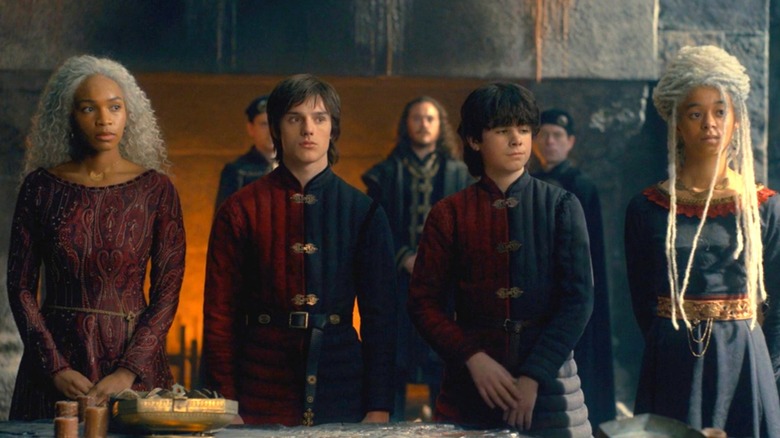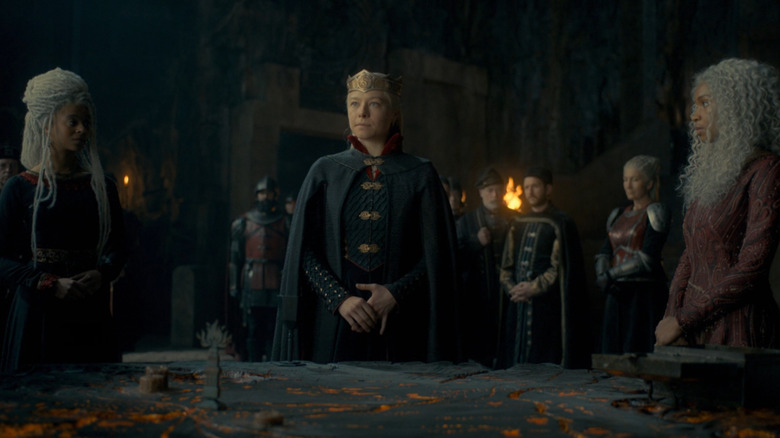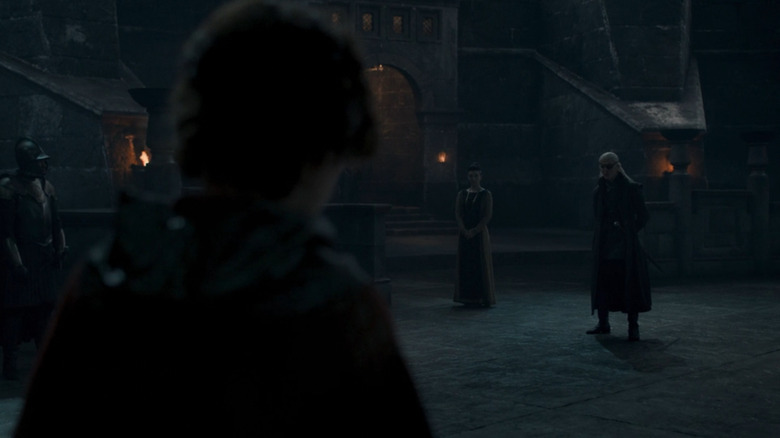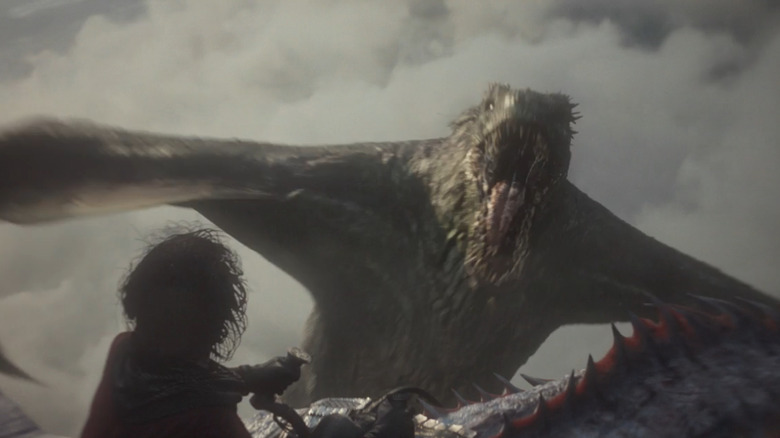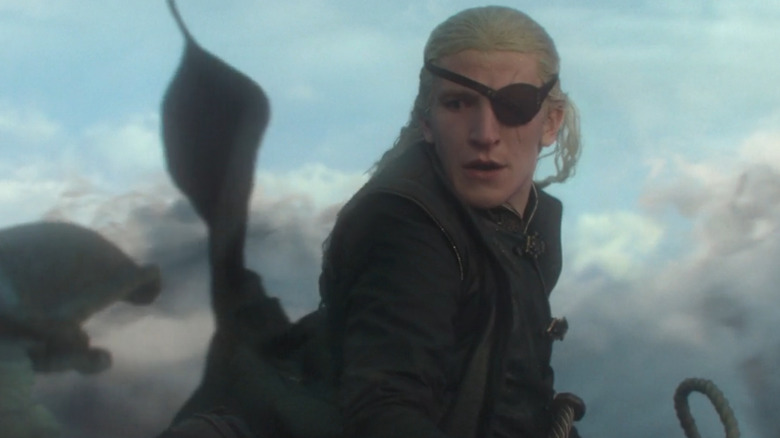House Of The Dragon's Big Finale Death Was Handled Much Differently In The Book
It wouldn't be a show based in the fictional land of Westeros without a few late-season deaths that help dictate the show's future. "House of the Dragon," a prequel to the "Game of Thrones" series, is based on George R. R. Martin's book, "Fire and Blood." As a collection of history lessons told by different types of people, "Fire and Blood" often offers interesting views on prolific events, although sometimes these reports do not offer any type of nuance. Suppose that is bound to happen when history is recounted by recitation, as there is always a fair amount of embellishment and variation as a story is told over and over again.
Speaking with The Hollywood Reporter, series co-creator Ryan Condal spoke about how the production team of "House of the Dragon" isn't trying to reinvent the proverbial wheel and how they wanted to focus on what made its predecessor show so successful. He added, "Hopefully, fans will enjoy it for the thing that it is. We'll be lucky if we ever come close to what the original show was, so we're just putting our heads down and getting on with it and hoping what we come up with is worthy of having a 'Game of Thrones' title." Considering the rough arc of history provided in "Fire and Blood," the makers of "House of the Dragon" are given major events to cover, but it is up to them to truly flesh out the details. On account of this, the shocking death that viewers have just witnessed was presented quite differently in the books.
The tenth episode of House of the Dragon is a powder keg for a future conflict
The finale episode of Season 1 of "House of the Dragon" certainly feels like a powder keg about to be ignited. After the break-neck speed in which Aegon II (Tom Glynn-Carney) is crowned king in the previous episode after the death of Viserys (Paddy Considine), events have now been created that will see Westeros plunged into conflict. Obviously, Viserys had named his daughter Rhaenyra (Emma D'Arcy) as heir, and this rapid move by Alicent (Olivia Cook) and her father Otto Hightower (Rhys Ifans) to usurp her claim has already created a schism in lords and ladies, as seen by the ruthless actions of Otto to suppress dissent.
However, the coronation of Aegon II is not without its hiccups, as Princess Rhaenys (Eve Best) manages to free her dragon Meleys, which she uses to crash through the floor of the Dragon Pit of King's Landing during Aegon's coronation. A rather dramatic way of establishing where Rhaenys' loyalties may lie, Episode 10 picks up in the immediate aftermath, with Rhaenys explaining to Rhaenyra what has just transpired. Quickly summoning her council, as well as her husband-uncle Daemon (Matt Smith), Rhaenyra shows far more restraint than her compatriots, who begin to plan a war for succession immediately. Unfortunately, Rhaenyra's calm and collective demeanor isn't exactly rewarded later in the episode, as her careful approach to conflict is shattered by the heedless actions of children.
Lucerys is sent to treat with Borros Baratheon but runs into Aemond
Acknowledging that the faction now known as the "Greens" has far more soldiers and allies, Rhaenyra decides to dispatch messengers to different locations of Westeros to shore up support. Sending out her two children Jacaerys (Harry Collett) and Lucerys (Elliot Grihault) to different locations like Winterfell and Storm's End, the two brothers take to their dragons to reach these seats of power for famous families. Lucerys is sent to Storm's End to treat with Borros Baratheon (Roger Evans), although he quickly realizes that somebody has beaten him there. Coming face-to-face with his eye-patch-wearing uncle Aemond (Ewan Mitchell), Lucerys is unable to convince Borros to lend his support to his family's side, which is now called the "Blacks."
Realizing that he is ill-prepared for this negotiation, Lucerys attempts to leave, but before he is able to depart, Aemond demands that Lucerys cut his own eye out to make up for the wound Lucerys had inflicted on Aemond in their shared youth. However, Borros does not care for this bluster and allows Lucerys to leave. Taking to his young dragon Arrax, who is greatly unsettled by the ongoing intense storm, Lucerys begins to fly back to Dragonstone but soon realizes that Aemond is in pursuit with Vhagar, the largest and most fearsome dragon in the world. Upon his dragon, Aemond taunts Lucerys, still demanding his eye, but both Aemond and Lucerys have trouble controlling their dragons on account of them being untested dragonriders, at least when it comes to dragon-on-dragon combat.
In Fire and Blood, Aemond meant to kill Lucerys, but the show makes it appear as an accident
As Aemond's pursuit of Lucerys becomes more and more dire, Lucerys' dragon Arrax is visibly shaken, and both dragons appear to be letting their primal instincts take over, despite the protests of both riders. As the hunter, Vhagar's size is incredibly apparent, though this doesn't stop Arrax from blasting the ancient dragon with fire. This in turn causes Vhagar to release its full fury upon both Arrax and Lucerys, and in an instant both dragon and rider are killed with a ravenous bite from Vhagar, much to the shock of Aemond, who now realizes that his actions will have far reaching consequences.
As shocking as this scene was for viewers, this scene actually has far more nuance than what was presented in "Fire and Blood." According to A Wiki of Ice and Fire, this moment is considered a defining moment in the conflict called "The Dance of Dragons," and several different variations of the story were told regarding what happened, but all agreed upon one thing — Lucerys and Arrax were tragically under-matched against Aemond and Vhagar, as Vhagar was five times the size of Arrax. Although fans see a look of concern and fear wash across Aemond's face after the killing, this is absent from the book.
This is on account of the retold nature of "Fire and Blood," which portrayed the fight as one sided and very intentional, with Aemond motivated primarily by revenge. There are even several stories about the aftermath of the fight, with some saying that Arrax's head washed ashore, others saying that both Lucerys and Arrax were swallowed whole, or that Lucerys actually survived but suffered from permanent amnesia. Either way, Lucerys was never found.
Series co-creator Ryan Condal explains the change from the source material
This change in "House of the Dragon" from "Fire and Blood" makes it much more of a dynamic story, which is important because this moment is what actually sets off the Targaryen civil war in Westeros. Although Rhaenyra didn't want to strike the first blow, she was given her wish, though at a terrible price. For viewers to see Aemond realize his actions will have perilously disastrous consequences definitely adds an extra layer of the story, and it will be interesting to see how Aemond will report the deadly outcome to the rest of his family.
In an interview with Variety, series co-creator Ryan Condal was asked about why they decided to make Lucerys' death an accident, and not intentional. He clarified that even though it is presented as an accident, Aemond still jumped onto his dragon and chased his nephew, so it isn't as clear-cut as just a mistake. Condal then explained how history itself is messy, and how the historians and storytellers of Westeros couldn't actually know what was going through Aemond's head. Condal added, "This is a war of many cuts that lead to a really, really bloody wound. It adds complexity and nuance to the character that's potentially interesting. There's lots of runway to go on with Aemond as a character and the story of the Dance. This is his first act as a dragon rider and a warrior and it's gone very wrong. Now what happens as a result, and how does he respond? Those are the questions I'm interested in as dramatist." Ultimately, this departure from the source material definitely adds yet another layer to the upcoming conflict and how both sides will respond will shape the history of Westeros.
